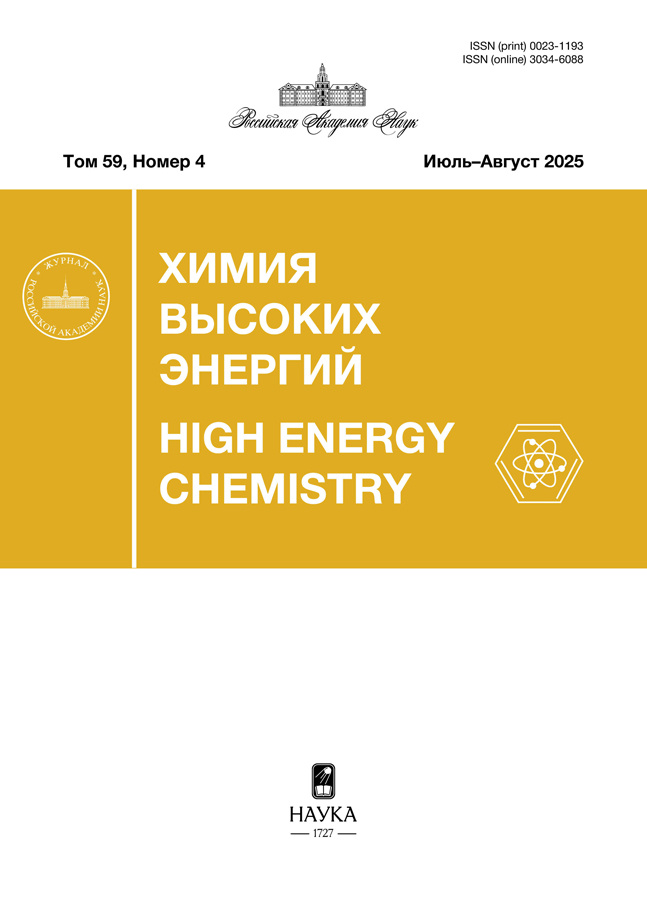Photophysical properties of pyrene-containing biphotocromic dyads and corresponding cyclobutanes formed from dyads in the [2+2] photocycloaddition reaction
- Авторлар: Budyka M.F.1, Li V.M.1, Gavrishova T.N.1, Tovstun S.A.1
-
Мекемелер:
- Federal Research Center of Problems of Chemical Physics and Medicinal Chemistry, RAS
- Шығарылым: Том 59, № 4 (2025)
- Беттер: 189-200
- Бөлім: ФОТОХИМИЯ
- URL: https://j-morphology.com/0023-1193/article/view/687804
- DOI: https://doi.org/10.31857/S0023119325040018
- EDN: https://elibrary.ru/axdslk
- ID: 687804
Дәйексөз келтіру
Аннотация
The photophysical properties of biphotochromic dyads DoX and D10 containing two identical photochromes, 2-[2-(pyrene-1-yl)ethenyl]-quinoline (PEQ), linked by bridge groups of different lengths, as well as the corresponding dipyrenylcyclobutanes CBoX and CB10 formed from the dyads in the [2+2] photocycloaddition reaction (PCA) have been investigated by time-resolved emission spectroscopy (TRES). On the basis of TRES, the number of emitters was determined, their emission spectra, excited state lifetimes, and rate constants of competitive physical and chemical processes (emission, energy transfer, and reactions) were calculated. In dyads, the formation of excimers, possible intermediates of the PCA reaction, was detected by the appearance of emitters with lifetimes significantly increased compared to the model PEQ-photochrome. In cyclobutanes, a decrease in the lifetime of pyrene substituents as compared to 1-methylpyrene shows the energy transfer from substituents to the cyclobutane ring, which, according to the predissociation mechanism, initiates the ring-opening reaction (retro-PCA). In addition, CBoX shows the presence of non-emitting conformers. Quantum chemical calculations by DFT method confirmed the possibility of formation of different conformers of cyclobutane CBoX, differing in the relative position of pyrenyl substituents and the degree of their interaction with each other.
Толық мәтін
Авторлар туралы
M. Budyka
Federal Research Center of Problems of Chemical Physics and Medicinal Chemistry, RAS
Хат алмасуға жауапты Автор.
Email: budyka@icp.ac.ru
Ресей, Chernogolovka
V. Li
Federal Research Center of Problems of Chemical Physics and Medicinal Chemistry, RAS
Email: budyka@icp.ac.ru
Ресей, Chernogolovka
T. Gavrishova
Federal Research Center of Problems of Chemical Physics and Medicinal Chemistry, RAS
Email: budyka@icp.ac.ru
Ресей, Chernogolovka
S. Tovstun
Federal Research Center of Problems of Chemical Physics and Medicinal Chemistry, RAS
Email: budyka@icp.ac.ru
Ресей, Chernogolovka
Әдебиет тізімі
- Liang C.K., Desvergne J.P., Bassani D.M. // Photochem. Photobiol. Sci. 2014. V. 13. P. 316.
- Perrier A., Maurel F., Jacquemin D. // Acc. Chem. Res. 2012. V. 45. P. 1173.
- Kirkus M., Janssen R.A. J., Meskers S.C. J. // J. Phys. Chem. A. 2013. V. 17. P. 4828.
- Margulies E.A., Shoer L.E., Eaton S.W., Wasielewski M.R. // Phys. Chem. Chem. Phys. 2014. V. 16. P. 23735.
- Long S., Wang Y., Vdovic S., Zhou M., Yan L., Niu Y., Guo Q., Xia A. // Phys. Chem. Chem. Phys. 2015. V. 17. P. 18567.
- Cho D.W., Fujitsuka M., Sugimoto A., Majima T. // J. Phys. Chem. A. 2008. V. 112. P. 7208.
- Wang S., Bohnsack M., Megow S., Renth F., Temps F. // Phys. Chem. Chem. Phys. 2019. V. 21. P. 2080.
- Kucukoz B., Adinarayana B., Osuka A., Albinsson B. // Phys. Chem. Chem. Phys. 2019. V. 21. P. 16477.
- Letrun R., Lang B., Yushchenko O., Wilcken R., Svechkarev D., Kolodieznyi D., Riedle E., Vauthey E. // Phys. Chem. Chem. Phys. 2018. V. 20. P. 30219.
- Chahal M.K., Liyanage A., Gobeze H.B., Payne D.T., Ariga K., Hill J.P., D’Souza F. // Chem. Commun. 2020. V. 56. P. 3855.
- Doddi S., Ramakrishna B., Venkatesha Y., Bangl P.R. // RSC Adv. 2015. V. 5. P. 56855.
- Kim D., Park S.Y. // Optical Mater. 2018. 1800678.
- Szacilowski K. // Chem. Rev. 2008. V. 108. P. 3481.
- Будыка М.Ф. // Успехи химии. 2017. Т. 86. С. 181.
- Andreasson J., Pischel U. // Coord. Chem. Rev. 2021. V. 429. 213695.
- Будыка М.Ф., Поташова Н.И., Гавришова Т.Н., Ли В.М., Гак В.Ю., Гринева И.А. // Химия высоких энергий. 2018. Т. 52. С. 204.
- Будыка М.Ф., Ли В.М., Гавришова Т.Н. // Химия высоких энергий. 2024. Т. 58. С. 77.
- Будыка М.Ф., Ли В.М., Гавришова Т.Н. // Химия высоких энергий. 2025. Т. 59. С. 26.
- Budyka M.F., Gavrishova T.N., Li V.M., Potashova N.I., Fedulova J.A. // Spectrochim. Acta Part A. 2022. V. 267. 120565.
- Budyka M.F., Fedulova J.A., Gavrishova T.N., Li V.M., Potashova N.I., Tovstun S.A. // Phys. Chem. Chem. Phys. 2022. V. 24. P. 24137.
- Будыка М.Ф., Гавришова Т.Н., Ли В.М., Дозморов С.А. // Изв. АН. Сер. хим. 2023. Т. 72. С. 2013.
- Frisch M.J., Trucks G.W., Schlegel H.B. et al. Gaussian 09, Revision D.01. Gaussian, Inc., Wallingford CT, 2013.
- Mazzucato U., Momicchioli F. // Chem. Rev. 1991. V. 91. P. 1679.
- Schillmoller T., Herbst-Irmer R., Stalke D. // Adv. Optical Mater. 2021. V. 9. 2001814.
- Будыка М.Ф. // Успехи химии. 2012. Т. 81. С. 477.
- Ellsei F., Aloisi G.G., Latterini L., Galiazzo G., Gorner H. // J. Chem. Soc. Faraday Trans. 1995. V. 91. P. 3117.
- Kovalenko N.P., Abdukadirov A., Gerko V.I., Alfimov M.V. // J. Photochem. 1980. V. 12. P. 59.
- Doi T., Kawai H., Murayama K., Kashida H., Asanuma H. // Chem. Eur. J. 2016. V. 22. P. 10533.
- Truong V.X., Li F., Ercole F., Forsythe J.S. // ACS Macro Lett. 2018. V. 7. P. 464.
- Budyka M.F., Gavrishova T.N., Li V.M., Potashova N.I., Ushakov E.N. // ChemistrySelect. 2021. V. 6. P. 3218.
- Winnik F.M. // Chem. Rev. 1993. V. 93. P. 587.
Қосымша файлдар





















